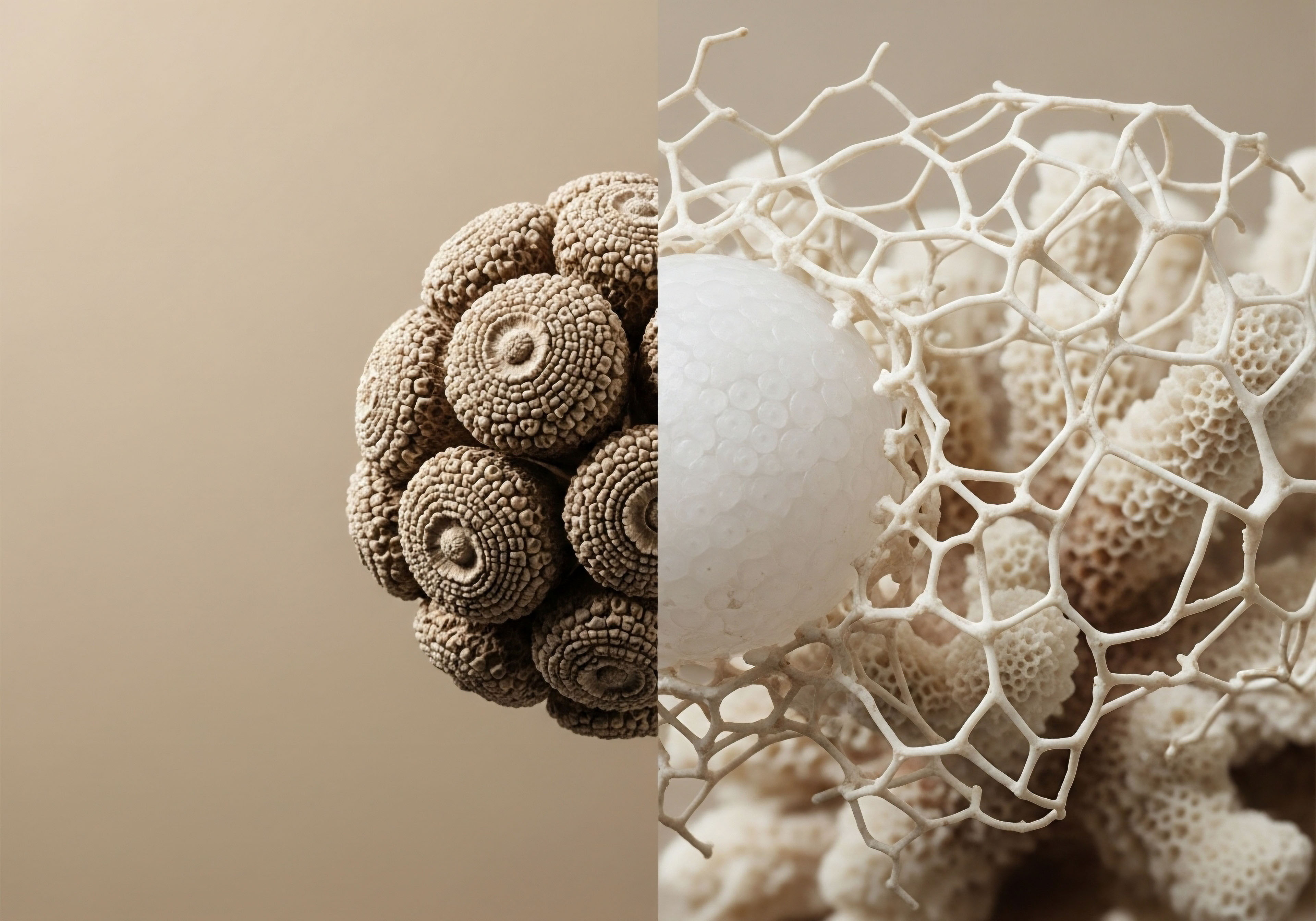

Fundamentals
When you begin to notice shifts in your vitality, perhaps a subtle decline in energy or a change in how your body responds, it is natural to seek explanations and solutions. Many individuals find themselves considering hormonal optimization protocols as a path to reclaiming their previous state of well-being.
A common and valid concern arises for men considering such protocols, particularly regarding prostate health. This concern is not a minor detail; it reflects a deep-seated desire to pursue health improvements without compromising other vital bodily systems. Understanding the intricate balance of your biological systems is the first step toward making informed decisions about your personal health trajectory.
The prostate gland, a small organ situated below the bladder in men, plays a significant role in reproductive function. Its health is intrinsically linked to the endocrine system, particularly the actions of androgens. These powerful signaling molecules, with testosterone being the primary example, orchestrate numerous bodily processes, from muscle mass and bone density to mood and cognitive sharpness. As men age, natural declines in androgen levels can lead to a constellation of symptoms, often prompting discussions about testosterone replacement therapy.
Understanding your body’s hormonal landscape is essential for navigating health decisions, especially concerning prostate well-being during androgen protocols.

Androgens and Prostate Function
Androgens exert their influence by binding to specific receptors within cells, including those of the prostate. This interaction stimulates cellular growth and differentiation, a normal and necessary process for maintaining prostate size and function throughout life. The prostate, like other androgen-sensitive tissues, relies on these signals for its regular operations. When external androgen protocols are introduced, the body’s internal messaging system receives amplified signals, which can raise questions about the prostate’s response.
A key player in this process is the enzyme 5-alpha reductase, which converts testosterone into a more potent androgen, dihydrotestosterone (DHT). DHT is a primary driver of prostate growth. While essential for male development, excessive DHT activity in later life can contribute to conditions such as benign prostatic hyperplasia (BPH), a non-cancerous enlargement of the prostate. This biological pathway underscores why careful consideration of androgen levels is paramount when discussing prostate health.

Initial Considerations for Androgen Protocols
Before initiating any hormonal optimization protocol, a thorough assessment of current health status is non-negotiable. This includes a detailed medical history, a physical examination, and comprehensive laboratory testing. For men, this means evaluating baseline prostate-specific antigen (PSA) levels and, when appropriate, a digital rectal examination (DRE). These initial screenings provide a crucial snapshot of prostate health, establishing a reference point against which future changes can be measured.
The decision to proceed with an androgen protocol is a collaborative one, made between an individual and their healthcare provider. It involves weighing the potential benefits of improved vitality, metabolic function, and overall well-being against any potential risks, particularly those related to prostate health. This careful deliberation ensures that the chosen path aligns with an individual’s health goals while prioritizing safety and long-term outcomes.


Intermediate
For individuals considering or undergoing hormonal optimization, the management of prostate health during extended androgen protocols represents a significant area of clinical consideration. The objective is to support systemic vitality while vigilantly monitoring and mitigating any potential impact on the prostate gland. This requires a precise understanding of therapeutic agents and their physiological effects.

Monitoring Prostate Health during Androgen Protocols
Regular monitoring forms the bedrock of safe androgen administration. The primary tools for assessing prostate health during these protocols are prostate-specific antigen (PSA) testing and digital rectal examinations (DRE). PSA is a protein produced by prostate cells, and elevated levels can sometimes indicate prostate enlargement, inflammation, or, in some instances, prostate cancer. A baseline PSA measurement is taken before commencing therapy, followed by periodic re-evaluations.
Clinical guidelines typically recommend PSA re-evaluation at specific intervals, such as three to six months after initiation of therapy, and then annually thereafter. Any significant increase in PSA from baseline, or a rapid rate of change, warrants further investigation. The DRE, performed by a clinician, allows for physical assessment of the prostate’s size, shape, and texture, providing additional clinical context.
Consistent monitoring of PSA levels and regular digital rectal examinations are essential for safeguarding prostate health during androgen optimization.

Tailored Androgen Protocols for Men
Testosterone replacement therapy (TRT) for men typically involves weekly intramuscular injections of Testosterone Cypionate. A standard dosage might be 200mg/ml, adjusted based on individual response and laboratory values. To maintain natural testicular function and fertility, Gonadorelin is often co-administered, typically via subcutaneous injections twice weekly. This peptide stimulates the pituitary gland to release luteinizing hormone (LH) and follicle-stimulating hormone (FSH), which are vital for endogenous testosterone production and spermatogenesis.
Another consideration is the conversion of testosterone to estrogen, which can lead to undesirable effects. To manage this, an aromatase inhibitor like Anastrozole is frequently prescribed, often as an oral tablet twice weekly. This medication helps to modulate estrogen levels, preventing symptoms such as gynecomastia or excessive water retention. In some cases, Enclomiphene may be included to further support LH and FSH levels, particularly when fertility preservation is a priority.
Here is a table summarizing common components in male TRT protocols:
| Component | Typical Administration | Primary Purpose |
|---|---|---|
| Testosterone Cypionate | Weekly intramuscular injection | Androgen replacement |
| Gonadorelin | 2x/week subcutaneous injection | Maintain natural testosterone production and fertility |
| Anastrozole | 2x/week oral tablet | Block estrogen conversion, reduce side effects |
| Enclomiphene | Oral tablet (as needed) | Support LH and FSH levels |

Androgen Protocols for Women
Hormonal balance for women also frequently involves targeted androgen support, particularly for symptoms like low libido, fatigue, or mood fluctuations. Protocols for women differ significantly in dosage and administration methods compared to men. Testosterone Cypionate is typically administered in much smaller doses, often 10 ∞ 20 units (0.1 ∞ 0.2ml) weekly via subcutaneous injection. This micro-dosing aims to restore physiological levels without inducing virilizing effects.
The inclusion of Progesterone is common, with its prescription tailored to menopausal status. For pre-menopausal women, progesterone supports menstrual cycle regularity and uterine health. In peri-menopausal and post-menopausal women, it addresses symptoms like hot flashes and sleep disturbances, and provides uterine protection when estrogen is also administered. Pellet therapy, offering long-acting testosterone, can also be an option, with Anastrozole considered when appropriate to manage estrogen levels.

Post-TRT and Fertility Protocols
For men who discontinue TRT or are actively pursuing conception, a specific protocol is implemented to restore endogenous hormone production. This protocol aims to reactivate the body’s natural signaling pathways that were suppressed during exogenous testosterone administration. The regimen typically includes:
- Gonadorelin ∞ To stimulate the hypothalamic-pituitary axis, encouraging LH and FSH release.
- Tamoxifen ∞ A selective estrogen receptor modulator (SERM) that blocks estrogen’s negative feedback on the pituitary, thereby increasing LH and FSH secretion.
- Clomid (Clomiphene Citrate) ∞ Another SERM with a similar mechanism to Tamoxifen, promoting endogenous testosterone production.
- Anastrozole ∞ Optionally included to manage estrogen levels during the recovery phase, preventing excessive estrogen feedback that could hinder recovery.
This structured approach helps the body recalibrate its endocrine system, facilitating a smoother transition off exogenous hormones and supporting reproductive goals.


Academic
The scientific consideration of prostate health during extended androgen protocols requires a deep dive into the molecular and cellular mechanisms governing androgen action within the prostate gland. This involves understanding the complex interplay of hormones, receptors, and enzymatic pathways that collectively determine prostate growth and function. The overarching goal is to maintain systemic hormonal balance while mitigating any potential risks to prostate integrity.

Androgen Receptor Dynamics and Prostate Homeostasis
The prostate gland is exquisitely sensitive to androgens, primarily testosterone and its more potent metabolite, dihydrotestosterone (DHT). The enzyme 5-alpha reductase, particularly its type 2 isoform, is highly expressed in prostate stromal cells and converts testosterone to DHT. DHT binds to the androgen receptor (AR) with significantly higher affinity and stability than testosterone, leading to a more pronounced transcriptional activation of androgen-responsive genes. These genes regulate cellular proliferation, differentiation, and survival within the prostate epithelium and stroma.
Under physiological conditions, this androgen signaling maintains prostate homeostasis. However, in the context of extended androgen protocols, the increased availability of exogenous testosterone can lead to elevated intraprostatic DHT levels, potentially stimulating prostate growth. This mechanism is central to the concern regarding benign prostatic hyperplasia (BPH) and, less directly, prostate cancer progression. Research indicates that while exogenous testosterone does not inherently initiate prostate cancer, it can accelerate the growth of pre-existing, undiagnosed microscopic foci.
The intricate balance of androgen receptor signaling and 5-alpha reductase activity dictates prostate cellular responses to hormonal fluctuations.

The Role of Estrogen and the Androgen-Estrogen Axis
Beyond direct androgenic effects, the role of estrogen in prostate health is increasingly recognized as significant. Testosterone is aromatized to estradiol by the enzyme aromatase, which is also present in prostate tissue. Estrogen receptors (ERα and ERβ) are expressed in the prostate, and their activation can influence prostate cell proliferation and apoptosis. ERα activation is generally associated with prostate growth and inflammation, while ERβ activation may have protective effects.
During androgen protocols, particularly with higher testosterone dosages, increased aromatization can lead to elevated estradiol levels. This necessitates the careful use of aromatase inhibitors like Anastrozole to maintain an optimal androgen-to-estrogen ratio. An imbalance favoring estrogen, particularly ERα signaling, could contribute to prostate enlargement and potentially influence the prostate microenvironment in ways that are not conducive to long-term health.
The interplay between androgens and estrogens within the prostate is a complex endocrine dance, where both partners must be in harmony.
Consider the following summary of hormonal influences on prostate health:
| Hormone/Enzyme | Primary Action in Prostate | Relevance to Androgen Protocols |
|---|---|---|
| Testosterone | Direct AR activation, precursor to DHT and Estradiol | Exogenous source in TRT, impacts overall androgenic load |
| Dihydrotestosterone (DHT) | Potent AR activator, primary driver of prostate growth | Intraprostatic levels influenced by exogenous testosterone and 5-alpha reductase activity |
| 5-alpha Reductase | Converts Testosterone to DHT | Target for inhibitors (e.g. finasteride) to reduce DHT-mediated prostate growth |
| Estradiol | Activates Estrogen Receptors (ERα, ERβ) | Influences prostate cell proliferation; managed by aromatase inhibitors |
| Aromatase | Converts Testosterone to Estradiol | Enzyme targeted by Anastrozole to control estrogen levels |

Clinical Evidence and Long-Term Safety
Extensive clinical research has explored the relationship between testosterone replacement therapy and prostate outcomes. Meta-analyses and long-term observational studies generally indicate that TRT in hypogonadal men does not significantly increase the risk of prostate cancer incidence. However, careful monitoring remains paramount, particularly for men with pre-existing, undiagnosed prostate cancer. The concern is not that TRT causes cancer, but that it might accelerate the growth of an already present, indolent tumor, making it clinically detectable.
For men with benign prostatic hyperplasia (BPH), TRT can sometimes lead to a modest increase in prostate volume and urinary symptoms, especially in the initial months of therapy. This typically stabilizes over time. Management strategies for BPH symptoms during TRT may include alpha-blockers or 5-alpha reductase inhibitors (e.g. finasteride, dutasteride), which directly target the mechanisms of prostate enlargement. These agents can be safely co-administered with androgen protocols to alleviate symptoms and manage prostate volume.
The ongoing dialogue between the hypothalamic-pituitary-gonadal (HPG) axis and peripheral tissues, including the prostate, highlights the systemic nature of hormonal health. Androgen protocols are not isolated interventions; they are part of a broader recalibration of the endocrine system. Understanding these intricate connections allows for a more precise and personalized approach to managing prostate health, ensuring that the pursuit of vitality is both effective and responsible.

References
- Morgentaler, Abraham. “Testosterone and Prostate Cancer ∞ An Historical Perspective on a Modern Myth.” European Urology, vol. 65, no. 5, 2014, pp. 974-976.
- Traish, Abdulmaged M. et al. “Testosterone and Prostate Health ∞ The Scientific and Clinical Evidence.” Journal of Urology, vol. 182, no. 6, 2009, pp. 2768-2773.
- Imam, Omar, et al. “The Role of Estrogen in Prostate Cancer ∞ A Review.” Urology, vol. 128, 2019, pp. 1-7.
- Kaplan, Steven A. et al. “Testosterone Replacement Therapy and Prostate Safety.” Current Opinion in Urology, vol. 26, no. 6, 2016, pp. 561-567.
- Khera, Mohit, et al. “A Systematic Review of the Effect of Testosterone Replacement Therapy on Prostate Tissue.” Journal of Sexual Medicine, vol. 11, no. 6, 2014, pp. 1493-1505.
- Shabsigh, Ridwan, et al. “Testosterone Therapy in Men with Benign Prostatic Hyperplasia.” Journal of Urology, vol. 177, no. 4, 2007, pp. 1466-1471.

Reflection
Considering your own biological systems and embarking on a path of hormonal optimization is a deeply personal undertaking. The information presented here serves as a guide, illuminating the complex interactions within your body, particularly concerning prostate health during androgen protocols. This knowledge is not merely a collection of facts; it is a lens through which you can view your own symptoms, concerns, and aspirations with greater clarity.
The journey toward reclaiming vitality and function without compromise is continuous. It involves listening to your body, interpreting its signals, and collaborating with clinical expertise to tailor protocols that honor your unique physiology. Each step taken, from initial assessment to ongoing monitoring, represents a commitment to your long-term well-being. May this understanding serve as a catalyst for your continued pursuit of optimal health, empowering you to navigate your personal path with confidence and informed decision-making.



